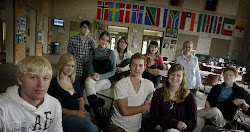On friday, we dedicated deligates had the opportunity to digress from our usual studies and go on a slight field trip. Our travels brought us across the Skagerrak (the strait separating Denmark and Sweden which is currently under Danish control) to the famous Louisiana Museum of Modern Art, located in Humlebæk, Denmark. The museum is well regarded as the most visited in all of Denmark with a gallery boasting works by such artists as Pablo Picasso and Andy Warhol. Although I might have easily spent an entire day traversing the grounds with beaming admiration of the arts, the attention of myself and the other delegates was centered around a specific exhibit that was very inspiringly entitled 'The World is Yours'. This exhibit centered around innovative architecture and city structure planning as a means of better human/environment interaction.  One of the fundamental pieces of the exhibit which I found to be thoroughly intriguing was the concept of 'Urban Dystopia'. In contrast to the ideals of an idealized utopian society, the idea of dystopia displays the potential negative effects of urbanization on the natural world and the quality of life for all living organisms. The project entitled 'Sustainable Dystopia', on display in the Louisiana, is a research project that undertakes ideas inherent to the comtemporary debate on the relationship between city and nature, and explores the various ideas for reconciling the two. The project is divided into three main themes: planting on vertical and horizontal surfaces of the city; innovative thinking about the interaction between animals and humans through a radical reconstructing of the distribution of urban space; division into animal zones and human zones; and a technological vision that focuses on sustainable use of energy of a city by way of solar and wind energy.
One of the fundamental pieces of the exhibit which I found to be thoroughly intriguing was the concept of 'Urban Dystopia'. In contrast to the ideals of an idealized utopian society, the idea of dystopia displays the potential negative effects of urbanization on the natural world and the quality of life for all living organisms. The project entitled 'Sustainable Dystopia', on display in the Louisiana, is a research project that undertakes ideas inherent to the comtemporary debate on the relationship between city and nature, and explores the various ideas for reconciling the two. The project is divided into three main themes: planting on vertical and horizontal surfaces of the city; innovative thinking about the interaction between animals and humans through a radical reconstructing of the distribution of urban space; division into animal zones and human zones; and a technological vision that focuses on sustainable use of energy of a city by way of solar and wind energy.
 The second scenerio displayed by the project shows the effects of renaturalization and reforestation-not only in peripheral areas but within designated urbanized spaces.
The second scenerio displayed by the project shows the effects of renaturalization and reforestation-not only in peripheral areas but within designated urbanized spaces. The third scenerio displayed by the project shows the effects of technological artificializing of living areas and the potentially totalitarian transformation.
The third scenerio displayed by the project shows the effects of technological artificializing of living areas and the potentially totalitarian transformation.
 Viewed through the lens of climate conscious students, this exhibition encouraged further thought on the relationship between innovative thought and human survival. Humans must learn to embrace their adaptive instincts at whatever the cost or else suffer and perish for lack of harmony with the natural world. I hope to further my climate change studies during this final and thrilling week of the COP15 with enthusiasm rooted in innovative thoughts towards the future of mankind's relationship with the natural world.
Viewed through the lens of climate conscious students, this exhibition encouraged further thought on the relationship between innovative thought and human survival. Humans must learn to embrace their adaptive instincts at whatever the cost or else suffer and perish for lack of harmony with the natural world. I hope to further my climate change studies during this final and thrilling week of the COP15 with enthusiasm rooted in innovative thoughts towards the future of mankind's relationship with the natural world.
 One of the fundamental pieces of the exhibit which I found to be thoroughly intriguing was the concept of 'Urban Dystopia'. In contrast to the ideals of an idealized utopian society, the idea of dystopia displays the potential negative effects of urbanization on the natural world and the quality of life for all living organisms. The project entitled 'Sustainable Dystopia', on display in the Louisiana, is a research project that undertakes ideas inherent to the comtemporary debate on the relationship between city and nature, and explores the various ideas for reconciling the two. The project is divided into three main themes: planting on vertical and horizontal surfaces of the city; innovative thinking about the interaction between animals and humans through a radical reconstructing of the distribution of urban space; division into animal zones and human zones; and a technological vision that focuses on sustainable use of energy of a city by way of solar and wind energy.
One of the fundamental pieces of the exhibit which I found to be thoroughly intriguing was the concept of 'Urban Dystopia'. In contrast to the ideals of an idealized utopian society, the idea of dystopia displays the potential negative effects of urbanization on the natural world and the quality of life for all living organisms. The project entitled 'Sustainable Dystopia', on display in the Louisiana, is a research project that undertakes ideas inherent to the comtemporary debate on the relationship between city and nature, and explores the various ideas for reconciling the two. The project is divided into three main themes: planting on vertical and horizontal surfaces of the city; innovative thinking about the interaction between animals and humans through a radical reconstructing of the distribution of urban space; division into animal zones and human zones; and a technological vision that focuses on sustainable use of energy of a city by way of solar and wind energy.The first scenerio displayed by the project shows the encouraged growth of plant matter on both vertical and horizontal surfaces.
 The second scenerio displayed by the project shows the effects of renaturalization and reforestation-not only in peripheral areas but within designated urbanized spaces.
The second scenerio displayed by the project shows the effects of renaturalization and reforestation-not only in peripheral areas but within designated urbanized spaces. The third scenerio displayed by the project shows the effects of technological artificializing of living areas and the potentially totalitarian transformation.
The third scenerio displayed by the project shows the effects of technological artificializing of living areas and the potentially totalitarian transformation. Viewed through the lens of climate conscious students, this exhibition encouraged further thought on the relationship between innovative thought and human survival. Humans must learn to embrace their adaptive instincts at whatever the cost or else suffer and perish for lack of harmony with the natural world. I hope to further my climate change studies during this final and thrilling week of the COP15 with enthusiasm rooted in innovative thoughts towards the future of mankind's relationship with the natural world.
Viewed through the lens of climate conscious students, this exhibition encouraged further thought on the relationship between innovative thought and human survival. Humans must learn to embrace their adaptive instincts at whatever the cost or else suffer and perish for lack of harmony with the natural world. I hope to further my climate change studies during this final and thrilling week of the COP15 with enthusiasm rooted in innovative thoughts towards the future of mankind's relationship with the natural world.


No comments:
Post a Comment